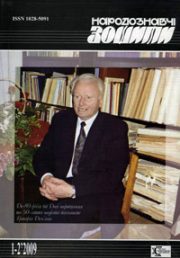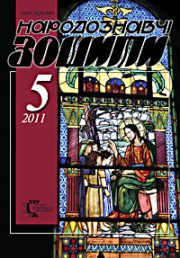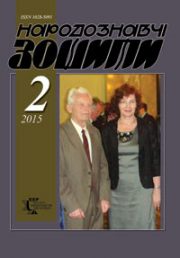The Ethnology Notebooks. 2025. № 4 (184), 800—820
UDK738.3:745] (477.8‒89Гуц)
DOI https://doi.org/10.15407/nz2025.04.800
IVASHKIV Halyna
- ORCID ID: https://orcid.org/0000-0003-2359-6735
- Doctor of Sciences in Art Criticism,
- Senior Scholar at the Ethnology Institute
- at the Academy of Sciences of Ukraine,
- Folk Art Department
- at the Museum of Ethnography, Arts and Crafts,
- 15 Svoboda Ave., 79000, Lviv, Ukraine,
- Contacts: e-mail: halynaivashkiv@ukr.net
Abstract. The given article analyzes major processes of formation and artistic peculiarities of the collection of Hutsul earthenware of the 19th c. in one of the biggest museums of Halychyna region at that time, namely the Dzieduszycki Museum. The paper accentuates unique features of the collection as for the authors, in particular the names of renowned potters from Kosiv (e. g. Ivan and Mykhailo Baraniuk, Oleksa Bakhmatiuk) and Pistyn (Petro Koshak), as well as highlights fundamental shapes and décor of the earthenware.
We believe two earthenware icons of 1811 by Matviy Kovalskyi with bust-length images of the Virgin with the Child and Saint Nicholas represent the oldest items. The images have very distinct facial features and the attributes that correspond to the iconographic manner of that time (i.e. oil icons painted on wood or canvas as well as icons on glass). Rare ceramic items also include an earthenware altar cross by Petro Koshak. It consists of two parts — the stand and the cross itself. Other pieces of church furnishing — candlesticks and lampstands by O. Bakhmatiuk and P. Koshak — are also artistically accomplished. The majolica tableware of both closed (jugs, «vodopiycha» cups round pots, O-shaped and flat jars) and open types (bowls, soup plates, and plates) is likewise distinguished by its vivid decorative features.
A small but important part of the collection includes terracotta and smoked pottery from the 19th c. It is notable for shapes traditional for Kosiv and Pistyn (globular pots and bowl-like vessels, jars, cups, three-legged pots with a lug or handle, colanders, flowerpots, etc.), decorated with scratching, burnishing, or ochre painting.
To this day, Hutsul earthenware from the Dzieduszycki Museum has been featured in numerous monographs, albums, and scholarly-artistic studies, mostly without reference to their provenance. The aim of this article is to verify the unique ceramic items that have been collected and preserved in this museum for future generations. The source base for addressing these issues includes the museum’s collection of Hutsul earthenware from the 19th c., the inventory books of the Museum of Ethnography, Arts and Crafts (MEC), archival documents from the Ethnology Institute at the National Academy of Sciences of Ukraine, and specialized publications, , especially the museum catalogue of the Ethnographic department (1899).
Keywords: the Dzieduszycki Museum, Hutsul earthenware, formation of the collection, ceramic centres, potters’ names, artistic peculiarities of the works.
Received 30.07.2025
REFERENCES
- https://ukrrid.blogspot.com/2019/10/volodimir-dIdushitskiy.html; https://greenworld.in.ua/index.php?id=175 26 6 5808
- Sokalski, B. (1899). Sokal Region. Lviv [in Polish].
- Shuchevych, W. (1902). Hutsul region. Lviv [in Polish].
- Ivashkiv, H. (Ed.). (2007). Vasyl Shostopalets and Sokal ceramics. Lviv [in Ukrainian].
- Ivashkiv, H. (2007). The Decor of Ukrainian Folk Earthenware of the 16th — first half of the 20th cc. Lviv [in Ukrainian].
- Ivashkiv, H., & Lozynskyi, T. (Eds.). (2012). Painted Earthenware of Kosiv and Pistyn in the 19th — Early 20th cc. Lviv [in Ukrainian].
- Ivashkiv, H. (2000). The Motif of «a Flowerpot» in Ukrainian Folk Earthenware of the 16th — first half of the 20th cc. The Ethnology notebooks, 5, 860—889 [in Ukrainian].
- Ivashkiv, H. (2003) Religious motifs and topics in Ukrainian folk ceramics. The Ethnology notebooks, 1—2, 313—322 [in Ukrainian].
- Ivashkiv, H. (2003). The main stages of the formation of the collection of folk ceramics in the Museum of Ethnography and Crafts. Ukrainian Ceramological Journal, 2—4, 44—59, 173—179 [in Ukrainian].
- Ivashkiv, H. (2005). Images of church buildings in ceramics. History of religions in Ukraine. Scientific yearbook (Book 2, pp. 664—671). Lviv [in Ukrainian].
- Ivashkiv, H. (2007). «Winged Dog» in ceramics by Oleksa Bakhmatyuk. Artistic Autograph, 2, 91—96 [in Ukra inian].
- Ivashkiv, H. (2007). The Image of Saint Nicholas in Kosiv Ceramics (Origins and Artistic Features). Existence in Art. Collection of Scientific Papers in Honor of Stepan Kostyuk on His 80th Anniversary (P. 224—232). Lviv [in Ukrainian].
- Ivashkiv, H. (2009). Ritual and ceremonial ceramics of Oleksa Bakhmatiuk. Apologist. Christian sacred tradition: faith, spirituality, art, 1—4, 191—196 [in Ukrainian].
- Ivashkiv, H. (2010) Motifs of bell towers and churches on clay products of potters from the Hutsul region. In Lemkos, Boykos, Ruthenians — history, present day, material and spiritual culture. B. 3 (pp. 237—242). Zielona Gоra [in Ukrainian].
- Ivashkiv, H. (2012). Earthen ware floor candlesticks of the 19th—20th cc.: typology and artistic structure. Art studies’12 (Pp. 79—94). Lviv [in Ukrainian].
- Ivashkiv, H. (2018). The phenomenon of Kosiv ceramics. Sights of Ukraine. History and culture, 10—12, 12—22 [in Ukrainian].
- Ivashkiv, H. (2021). Ukrainian folk figured ceramics of the 19th—20th centuries: plasticity of decor and form, concept of images. Abstract of the dissertation for the degree of Doctor of Art Studies in the specialty 17.00.06 — decorative and applied arts (P. 36). Lviv [in Ukrainian].
- Ivashkiv, H. (2021). Ukrainian folk figured ceramics of the 19th—20th centuries: plasticity of decor and form, concept of images. Dissertation for the degree of Doctor of Art Studies in the specialty 17.00.06 — decorative and applied arts (P. 440). Lviv [in Ukrainian].
- Archive of the Institute of Ethnology of the National Academy of Sciences of Ukraine. Description. 10. Preservation unit 2. Sheet 62—63 [in Ukrainian].
- (1899). The Dziedushycki Museum in Lviv. Department VII. Ethnography. Hutsul Region. Lviv [in Polish].
- The inventory book of the Lviv State Ethnographic Museum, 13 [in Ukrainian].
- Korol, S. (2020). Art and Industrial Exhibitions and the Revival of Ceramic Industry in Galicia. The Ceramic Code of Ivan Levynsky in the Aesthetic Dimension of a Ukrainian of the Late 19th — Early 20th Centuries (Pp. 22—31). Lviv; Kharkiv [in Ukrainian].
- National Agricultural and Industrial Exhibition. 7. 09. 1877. Supplement to the «Week» magazine, 3 [in Polish].
- National Agricultural and Industrial Exhibition. 6. 11. 1877. Supplement to the «Week» magazine, 23 [in Polish].
- National Agricultural and Industrial Exhibition. 26. 09. 1877. Supplement to the «Week» magazine, 17 [in Polish].
- Turkavskyi, M. (2004). Ethnographic exhibition of Pokuttya in Kolomyia (P. 39). Krakow [in Ukrainian].
- (1882, April 14). Rus’ Household Craft. Dilo [in Ukrainian].
- Franko, I. (1985). Ethnographic exhibition in Ternopil. Collection of works: in 50 vol. (Vol. 46, pp. 469—479). Kyiv [in Ukrainian].
- Retrieved from: https://ukrrid.blogspot.com/2019/10/volodimir-dIdushitskiy.html
- Bienkowski, A. (1900). The Dziedushycki Museum in Lviv and its creator. Illustrated Weekly, 12, 230—234 [in Polish].
- (1880). Catalogue of items from the Ethnographic Exhibition in Kolomyia. Lviv [in Polish].
- Retrieved from: https://greenworld.in.ua/index.php?id=1752 665808
- Folkiewicz, K. (1887). Information guide to the ethnographic exhibition organized in Ternopil in honor of the arrival of His Imperial Highness the Most Distinguished Archduke Rudolf. Ternopil [in Polish].
- (1890). Austria’s Domestic Industry: A Commentary on the Domestic Industry Section at the General Agricultural and Forestry Exhibition (P. 174). Vienna [in German].
- (1894). Letters from the National Exhibition. Time [in Polish].
- (1894). Catalogue of the Ethnographic Department of the 1894 National Exhibition in Lviv (Vol. CLXVI, p. 442). Lviv [in Polish].
- Franko, I. (1894). Ethnographic Department of the Exhibition. Lviv Courier, 228. Ch. I [in Polish].
- (1894). Awards at the Lviv exhibition Lviv Courier, 278 [in Polish].
- (1895). Guide to the Dzieduszycki Museum (Vol. XVI, p. 162). Lviv [in Polish].
- Retrieved from: https://uk.wikipedia.org/wiki/
- Arsenych, P. (1997). Ethnology of Volodymyr Shukhevych. In: Shukhevych V. Hutsul region. First and second parts. Reprint of the 1899 text (Pp. 7—24). Verkhovyna [in Ukrainian].
- Stankevych, M. (1992). Artistic ceramics. In: Antonovych, E.A., Zakharchuk-Chugai, R.V., Stankevych, M.E. Decorative and applied art (Pp. 77—85). Lviv [in Ukrainian].
- Lashchuk, Yu. (1998). Pokuttia ceramics (P. 160). Opishne [in Ukrainian].
- Totev, T. (1999). The Ceramic Icon in Medieval Bulgaria (P. 255). Sofia.
- Melegati, L. (1997). Ceramics (P. 192). Warsaw [in Polish].
- Chernohorsky, K. (1941). Moravian folk ceramics (P. 284). Prague [in Czech].
- Haberlandt, M. (1910). Austrian folk art from the collections of the Museum of Austrian Folk Art in Vienna. Vienna [in German].
- Hoberman, D. (2005). Motifs of Hutsul Ceramic Painting (P. 184). Kyiv [in Ukrainian].







